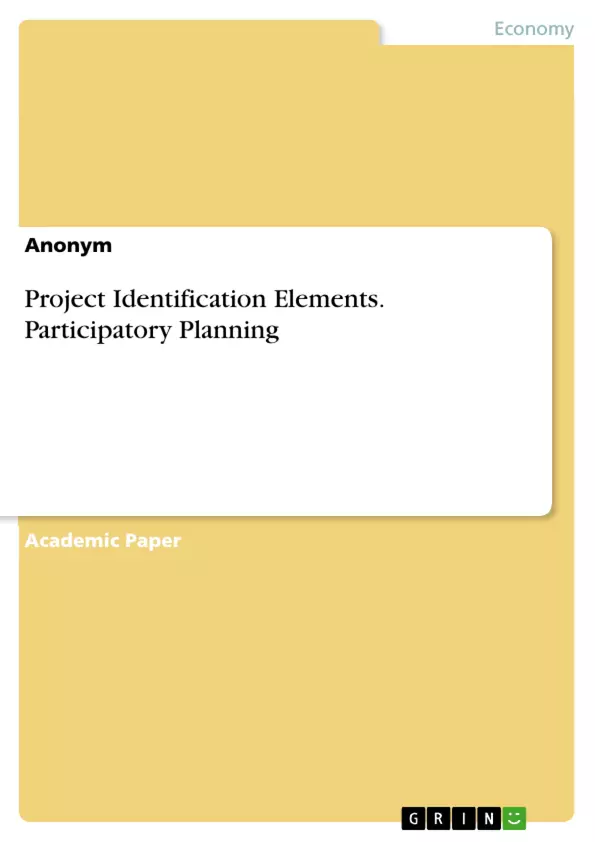This document covers aspects of project identification which include: the meaning of participatory planning, importance and the purpose of participatory planning. Salient features, what they are and what they entail. And finally two analysis methods which are stakeholder’s analysis and problem tree analysis. Each of these aspects have been further explained, analyzed and illustrated throughout the document.
Table of Contents
- Participatory Planning
- Purpose of Participatory Planning
- Salient Features
- Stakeholder Analysis
- Methods of Stakeholder Mapping
- Benefits
Objectives and Key Themes
This text aims to explain the concept of participatory planning, its purpose, and key features. It explores stakeholder analysis as a crucial tool within this planning paradigm.
- Definition and purpose of participatory planning
- Key features of effective participatory planning
- Methods for conducting stakeholder analysis
- Identifying and categorizing stakeholders (primary, secondary, key)
- Benefits of stakeholder analysis in project planning
Chapter Summaries
Participatory Planning: This section introduces the concept of participatory planning as an urban planning paradigm that emphasizes community involvement in strategic and management processes. It highlights the goal of harmonizing views, preventing conflict, and providing opportunities for marginalized groups to participate. The definition establishes the core principle of inclusive decision-making in urban and rural development.
Purpose of Participatory Planning: This section outlines the primary objectives of participatory planning. These objectives include identifying community needs, empowering disadvantaged groups, integrating local knowledge, securing political commitment and support, and fostering a two-way learning process between the project and the local population. The emphasis is on achieving sustainable and community-driven outcomes.
Salient Features: This section details the expected short-term and long-term outcomes of participatory planning. Short-term goals focus on generating a two-way learning process that tailors projects to local needs. Long-term objectives center on local empowerment and securing institutional support, ensuring the sustainability of the planning process and its impact. The focus is on creating lasting change.
Stakeholder Analysis: This section provides a comprehensive overview of stakeholder analysis, defining it as a systematic process for identifying and analyzing individuals or groups impacted by a proposed action. It describes how this analysis informs project planning, policy development, and conflict resolution. Different types of stakeholders (primary, secondary, key) are identified, highlighting their varying levels of influence and impact. The section also details various methods and techniques for mapping and analyzing stakeholder interests and power dynamics to foster cooperation and ensure successful project outcomes.
Keywords
Participatory planning, stakeholder analysis, community development, empowerment, conflict resolution, project management, local knowledge, sustainable development, two-way learning.
Frequently Asked Questions: A Comprehensive Guide to Participatory Planning
What is this text about?
This text provides a comprehensive overview of participatory planning, a method that emphasizes community involvement in planning processes. It details the purpose, key features, and benefits of this approach, with a particular focus on stakeholder analysis as a crucial tool for successful implementation.
What is Participatory Planning?
Participatory planning is an urban planning paradigm that prioritizes community involvement in strategic and management processes. Its core principle is inclusive decision-making, aiming to harmonize views, prevent conflict, and ensure the participation of marginalized groups in urban and rural development.
What is the purpose of Participatory Planning?
The primary objectives of participatory planning include identifying community needs, empowering disadvantaged groups, integrating local knowledge, securing political commitment and support, and fostering a two-way learning process between the project and the local population. The ultimate goal is to achieve sustainable and community-driven outcomes.
What are the salient features of Participatory Planning?
Short-term goals focus on creating a two-way learning process that tailors projects to local needs. Long-term objectives center on local empowerment and securing institutional support to ensure the sustainability of the planning process and its impact. The overall aim is to create lasting positive change.
What is Stakeholder Analysis and why is it important in Participatory Planning?
Stakeholder analysis is a systematic process for identifying and analyzing individuals or groups impacted by a proposed action. In participatory planning, it informs project planning, policy development, and conflict resolution. By identifying primary, secondary, and key stakeholders and their varying levels of influence, it helps foster cooperation and ensure successful project outcomes.
How can I conduct a Stakeholder Analysis?
The text explores various methods and techniques for mapping and analyzing stakeholder interests and power dynamics. While specific methods aren't detailed, the importance of understanding stakeholder influence and impact is emphasized to enable effective collaboration.
What are the benefits of Stakeholder Analysis?
Stakeholder analysis helps in identifying and addressing potential conflicts, securing buy-in from key players, and tailoring projects to better meet community needs. Ultimately, it improves the likelihood of project success and ensures sustainability.
What are the key terms associated with Participatory Planning?
Key terms include participatory planning, stakeholder analysis, community development, empowerment, conflict resolution, project management, local knowledge, sustainable development, and two-way learning.
- Quote paper
- Anonym (Author), 2019, Project Identification Elements. Participatory Planning, Munich, GRIN Verlag, https://www.grin.com/document/962188



